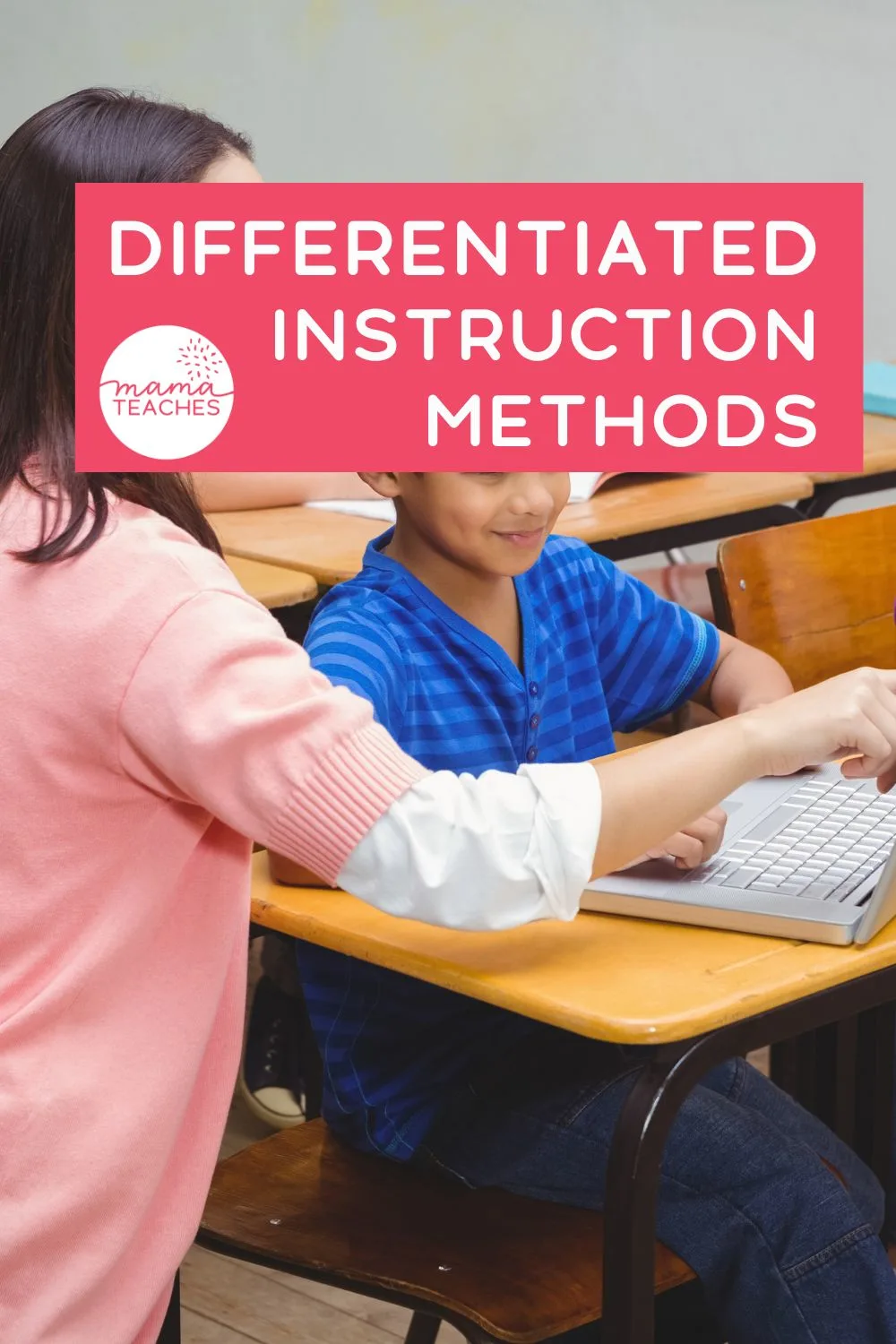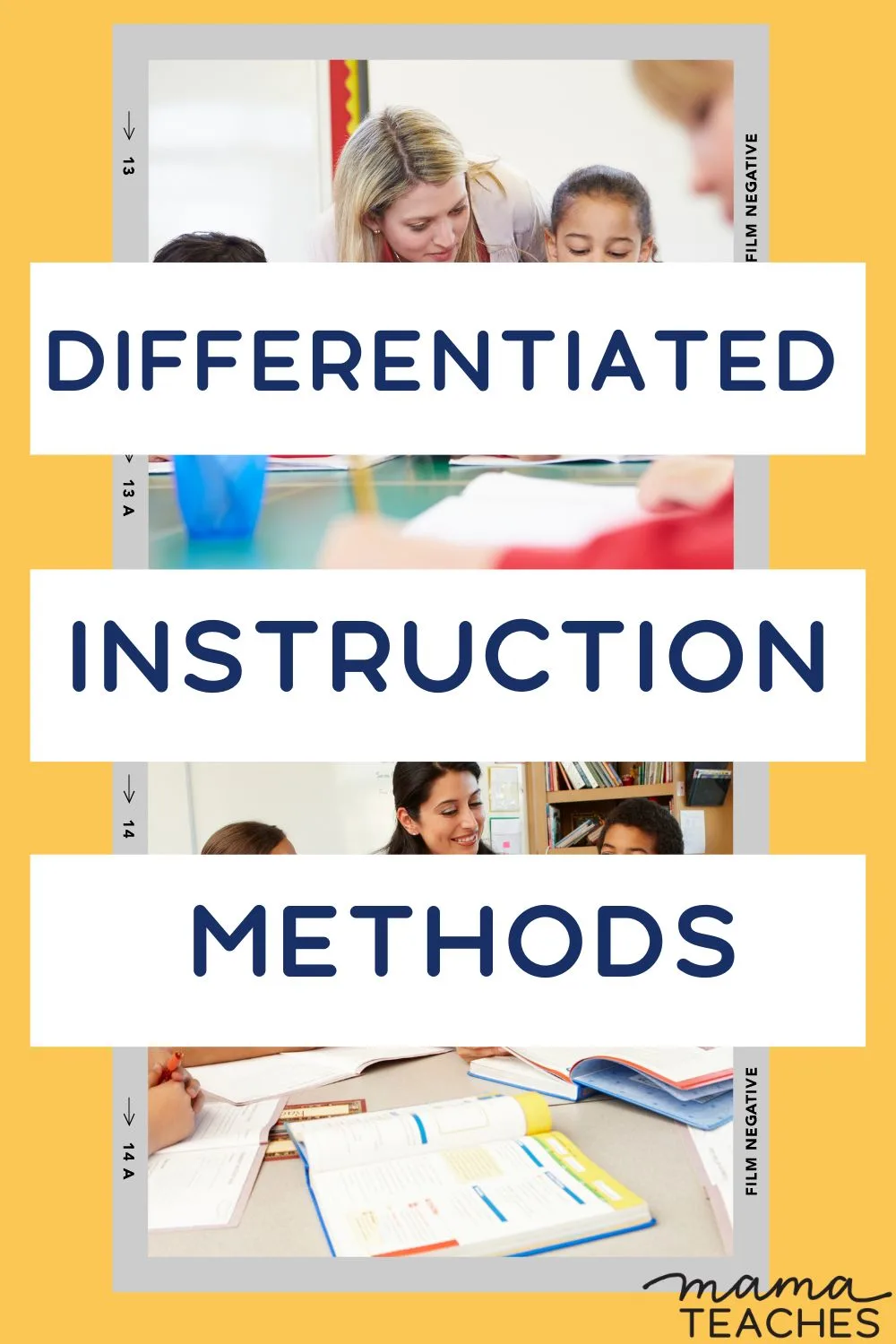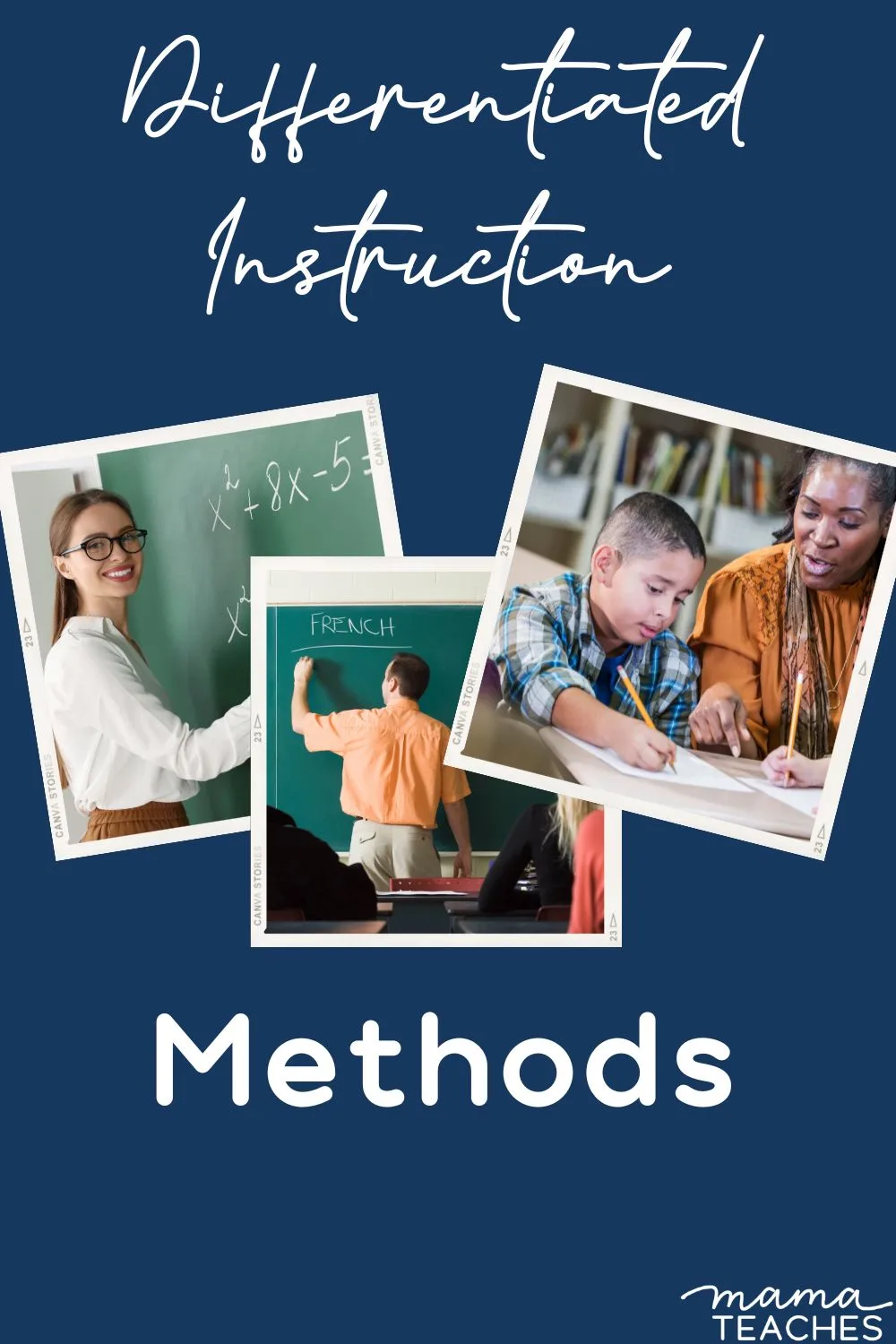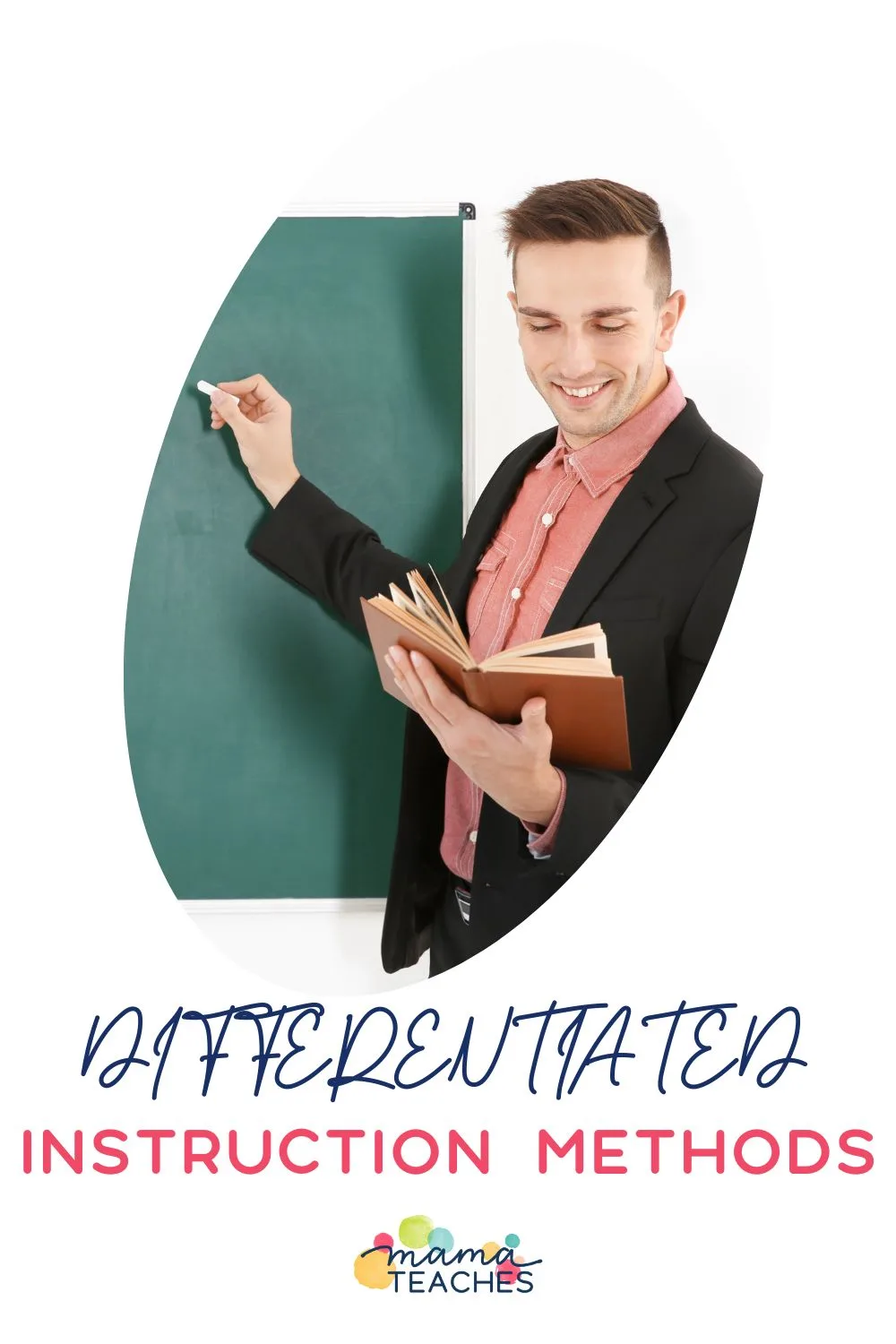You have a class full of students–how do you meet their individual educational needs? Try some of these differentiated instruction methods.

What Is Differentiated Instruction?
Differentiated instruction means tailoring the instructions, lesson content, and assessment to the student’s needs.
Differentiated instruction considers your students’ learning styles, interests, and readiness.
It makes your classroom a more inclusive and effective learning environment.

This article contains affiliate links to things that you might like.
Key Components of Differentiated Instruction
When you use differentiated instruction methods, that implies that you are changing or modifying something.
Here are some ways to differentiate instruction:
Content
You may not have much flexibility in the content you present, but modify it where you can to appeal to your students’ interests.
For example, you can create math word problems that feature students and their hobbies.
You can create handwriting practice or spelling sentences that students find interesting.
Draw comparisons in literature and history to stories and events that your students care about.
For example, how was the American Revolution like Star Wars? How was it different?
Pace
Students learn at different rates.
Some students will immediately grasp a math concept and may get bored as you walk through example after example.
Other students will be lost if you cover a concept too quickly.
It is important to note that students move at different rates in different subjects.
You may need to adjust your pace for different students.
This may mean you walk through a worksheet together, completing every problem with the students.
At the same time, you allow students to peel off and complete the worksheet independently if they would like (and provide them with an early finishing activity).

Depth
When we are excited about a topic, we want to share that excitement with our students.
This can overwhelm some students to the point that they can’t absorb anything.
Other students may spark to the content and complete their own research.
By using some differentiated instruction, you can cover the same topic at varying depths with individual students.
Instructions
For some students, figuring out how to complete an assignment is half the work.
You may need to provide written instructions, anchor charts, or graphic organizers to help students complete an activity.
Assessment
How do you assess a student’s understanding of the material?
This is another place where you can differentiate instruction.

How to Implement Differentiated Instruction Methods
Here are the steps to differentiating instruction.
Step 1: Assess Your Students
This does mean you give your students test after test.
You want to perform three levels of assessment with every lesson.
First, do a pre-assessment. What do your students already know about the topic?
You can ask students to tell you what they know before you begin.
You can ask, “Give me a thumbs up if you know about writing quotations, a thumbs down if you don’t, and a sideways thumb if you know a little.”
Then, perform a mid-way assessment. Ask them about terms or procedures. What are they retaining?
Finally, conduct a post-assessment. This can be an informal assessment like question and answer, or it can be a project, writing assignment, or quiz.
Step 2: Adapt to Readiness and Learning Styles
Once you have a general idea of how much your students know about the topic you are about to introduce, you can tailor your lesson.
Keep it to the basics if your students are unfamiliar with the concept.
Teach the nuts and bolts first, and make sure everyone is on the same page.
Next, use different learning activities to maximize everyone’s learning strengths.
Provide visual aides like anchor charts and assign hands-on activities.
Make use of technology for interactive learning.

Step 3: Use Various Instructional Strategies
You don’t have to present every lesson from the front of the classroom.
You can use other instructional strategies such as partner learning, small group learning, or independent study.
Step 4: Offer Ongoing Support
Some students will need periodic check-ins.
You can provide additional assistance, instructions, and re-teaching to those who need it.
Step 5: Offer Choices for Post Assessment
Allow students choices in how they demonstrate their understanding of the material.
You don’t always have to use quantitative assessment methods like quizzes and tests.
You can assign presentations, projects, and writing assignments.
Give your students individualized feedback about their personal progress. Perfection is not the goal; progress is.

Overcoming Obstacles to Differentiated Instruction
Here are some common obstacles (and their solutions) to implementing differentiated instruction in the class.
Obstacle: It Takes Too Much Time to Plan
Solution: While it is true that you need to spend more time prepping with differentiated instruction, you can minimize that time by taking advantage of existing resources.
Plan with another teacher, find existing resources instead of creating your own, and gradually build your repertoire of activities over time.
Rome was not built in a day. Give yourself a break and start small.
Obstacle: It’s Too Much Work to Differentiate with a Large Class
Solution: There is only one of you, and if you have a large class, you may feel pulled in too many directions.
Use grouping strategies to your advantage. Break students into small groups, and visit groups rather than individual students.
Utilize help from teacher aides or parent volunteers.
Use technology as a teaching or review tool with some students while you work with others.
Obstacle: You Don’t Have the Resources
Solution: Indeed, teachers often have paper-thin budgets.
Advocate for what you want. Build a wish list. Make your case to the administration, class parents, friends, and family.
In the meantime, explore low-cost or free solutions and share existing resources with colleagues.

Obstacle: You Don’t Know How to Do This
Solution: You are halfway there! You are already doing your own research to educate yourself.
Check out the resources below for more information on differentiated instruction methods.
Foster a collaborative culture within your school and ask other teachers to share their best practices.
Seek out continuing education training on differentiated instruction. Mention to your administration that you would like to learn more.
Resources for Differentiated Instruction Methods
These resources will provide you with ample information on differentiated instruction methods.
How to Differentiate Instruction in Academically Diverse Classrooms
This book by Carol Ann Tomlinson is a practical approach to differentiating instruction in the classroom.
The Differentiated Classroom
Tomlinson’s second book is as good as the first. Practical and research-based.
Differentiation in Middle and High School
This book has specialized content for the middle and high school classroom.
ASCD.org
The Association for Supervision and Curriculum Development has a resources tab with many options.
You can attend one of their conferences (in person or virtual), read articles, listen to podcasts, and watch videos on differentiated instruction.
Edutopia
This teacher resource (founded by George Lucas) has loads of videos and articles on differentiated instruction and effective teaching strategies.
Online Courses
You can take online professional development courses (formally or informally) from sites like Teaching Channel, edX, and Coursera.
They all have courses on differentiated instruction.

Implementing Differentiated Instruction Methods in the Classroom
Your students all have different needs, interests, and readiness.
Differentiated instruction can make a huge difference in your classroom by ensuring that everyone learns.
Although it can seem overwhelming to try differentiated instruction, begin with baby steps.
The first step is to educate yourself (congratulations, you’ve already begun!) about what you could do to help meet your students’ needs.
Once you know what to do (or at least where to start), you can begin making small steps toward your goal.
